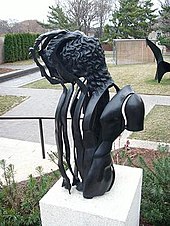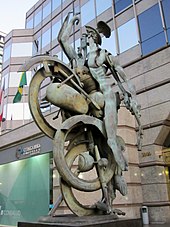Arman
Arman | |
|---|---|
Nouveau Réalisme, ZERO |
Arman (November 17, 1928 – October 22, 2005) was a French-born American artist.
Early life and education
Arman's father, Antonio Fernandez, an antiques dealer from
Completing his studies in 1949, Arman enrolled as a student at the
Early career


Early on, it was apparent that Arman's concept of the accumulation of vast quantities of similar objects was to remain a significant component of his art.[3] He had originally focused more attention on his abstract paintings, considering them to be of more consequence than his early accumulations of rubber stamps. In 1962, he began welding together Accumulations of similar kinds of metal objects, such as watches or axes.[1]
Inspiration and name change
Inspired by an exhibition for the German Dadaist Kurt Schwitters in 1954, Arman began working on Cachets, his first major artistic undertaking.[2] At his third solo exhibition held in Paris's Galerie Iris Clert in 1958, Arman showed some of his first 2D accumulations he called Cachets. These rubber stamp marks on paper and fabric proved a success and provided a change of course in his career.[2]
At the time, he was signing only with his first name as an homage to
Evolution of work
From 1959 to 1962, Arman developed his most recognizable style, beginning with his two most renowned concepts: Accumulations and Poubelles (French for "trash bins"). Accumulations were collections of commonplace and similar objects which he arranged within transparent
The Poubelles were collections of strewn refuse. In 1960, he filled the Iris Clert Gallery in Paris with trash, creating Le Plein (The Full) as a counterpoint to an exhibition called Le Vide (The Void) at the same gallery two years earlier by his friend Yves Klein.[3]
In October 1960, Arman,
In 1961, Arman made his debut in the United States, the country which was to become his second home. During this period, he explored creation via destruction. The Coupes (Cuts) and the Colères (Angers) featured sliced, burned, or smashed objects arranged on canvas, often using objects with a strong "identity" such as musical instruments (mainly violins and saxophones) or bronze statues.[3]
Arman and Warhol



Arman can be seen in
Move to New York City
Fascinated with the scene in
There were varied expressions of the Accumulations, including tools, watches, clocks, furniture, automobile parts, jewelry, and musical instruments in various stages of dismemberment. Musical instruments, specifically the strings
Of Arman's Accumulations, one of the largest is Long Term Parking,[5][6] which is on permanent display at the Château de Montcel in Jouy-en-Josas, France. Completed in 1982, this 60-foot (18 m) high sculpture consists of 60 mostly French cars set in 40,000 pounds (18,000 kg) of concrete. Just as ambitious was his 1995 work Hope for Peace,[7] which was specially commissioned by the Lebanese government to commemorate 50 years of their military's service. Standing in once war-torn Beirut, the 32-metre (105 ft) monument consists of 83 tanks and military vehicles.[2]
Personal life
In 1953, Arman married electronic music composer
After Arman's death in New York in 2005, some of his ashes were buried at the Père Lachaise Cemetery in Paris in 2008.[8]
Selected exhibitions and awards


1960s
1964
- Arman, Stedelijk Museum, Amsterdam, Holland
- Arman, Walker Art Center, Minneapolis, Minnesota
1965
- Arman, Museum Hans Lange, Krefeld, Germany
1966
- Arman, Palais de Beaux-Arts, Brussels, Belgium
- Arman, Musée de la Ville, Saint-Paul-de-Vence, France
1967
- Arman, Palazzo Grassi, Venice, Italy
1969
- Arman: Accummulations Renault (traveling exhibition):
- Stedelijk Museum, Amsterdam, Holland
- Musée des Arts Decoratifs, Paris, France
- Louisiana Museum of Modern Art
- Humlebaek, Denmark
- Kunsthalle, Berlin, Germany
- Städtische Kunsthalle, Düsseldorf, Germany
- Moderna Museet, Stockholm, Sweden
- Städtische Kunstammlungen, Ludwigshafen, Germany
- Kunsthaus, Zürich, Switzerland
- Amos Anderson Taidemuseo, Helsinki, Helsingfors, Finland
1970s
1970
- Arman, Modern Art Museum, Stockholm, Sweden
1973
Arman, Selected Activities. John Gibson Gallery, New York
1974
- Arman, Salles romanes du Cloître Saint-Trophime, Musée Réattu, Arles, France
- Arman: Selected Works 1958-1974, La Jolla Museum of Contemporary Art, California; *Fort Worth Art Museum, Texas
1975
- Arman: Objets Armés 1971-1974, Paris, Musée d'Art Moderne de la Ville de Paris, France
1976
- Arman, Artcurial auction house, Paris, France
1977
- Arman: Paintings and Sculptures, Ulrich Museum of Art, Wichita State University, Kansas
1978
- Arman, Veranneman Foundation, Kruishoutem, Belgium
1979
- Arman: Rétrospective, Centre d'Art et de Culture, Flaine, France
1980s
1980
- Arman, Veranneman Foundation, Kruishoutem, Belgium
1981
- Arman, Hessisches Landesmuseum, Darmstadt, Germany
1982
- Arman: Parade der Objekte: Retrospektive 1955-1982 (traveling exhibition):
- Kunstmuseum, Sammlung Sprengel, Hanover, Germany
- Hessisches Landesmuseum, Darmstadt, Germany
- Tel Aviv Museum, Israel
- Kunsthalle, Tübingen, Germany
- Musée Picasso, Château Grimaldi, Antibes, France
- Musée d'Art Contemporain Dunkerque, France
1984
- Arman o L’Oggetto come Alfabeto: Retrospettiva 1955-1984, Museo Civico delle Belle Arti, Lugano, Switzerland
- Arman, Museo d'Arte Moderna, Parma, Italy
1985
- Arman, Seibu Museum of Art, Tokyo, Japan; Walker Hill Art Center, Seoul, Korea
- Arman Aujourd’hui, Musée de Toulon, France
1986
- Arman: Retrospective, Wichita State University, Ulrich Museum of Art, Kansas
- Arman, Veranneman Foundation, Kruishoutem, Belgium
1990s
1991
- Arman in Italy, Fondazione Mudima, Milan, Italy
- Arman Sculpture, Contemporary Sculpture Center, Tokyo, Japan
- Arman: A Retrospective 1955 - 1991, The Brooklyn Museum, Brooklyn, New York; The Detroit Institute of Art, Detroit, Michigan
1992
- Il Giro di Arman, Associazione Culturale Italo-Francese, Bologna, Italy
1994
- Le Ceramica di Arman, Museo Internazionale delle Ceramiche in Faenza, Faenze, Italy
1995
- Arman, Musée Royal de Mariemont, Mariemont-Chapelle, Belgium
1996
- Arman: The Exhibition of International Sculpture Master, Modern Art Gallery, Taichung, Taïwan
1998
- Arman, Musée du Jeu de Paume, Paris, France
1999
- Arman, Tel Aviv Museum of Art, Israel
- Arman, Museu de Arte Moderna do Rio de Janeiro, Brazil; Museu de Arte de São Paulo Assis Chateaubriand, São Paulo, Brazil
- Arman: Fragmentation--Concerto for 4 Pianos, John Gibson Gallery, New York
21st Century
2000
- Arman—20 stations de l'objet, Couvent des Cordeliers, Paris, France
- Arman, Fundaciò "la Caixa," Barcelona, Spain
- Arman, la traversée des objets, Palazzo delle Zitelle, Venice, Italy
- Arman, Museo de Monterrey, Mexico
- Arman, National Museum of History, Taipei, Taiwan
2000-01
- Arman: Werke auf Papier, Ludwig Museum, Coblenz, Germany
2001-02
- Arman: Through and Across Objects, Boca Raton Museum of Art, Florida
2002
- Arman: Works on Paper, Villa Haiss Museum, Zell, Germany
2003
- Awarded 2003 Sport Artist of the Year, The American Sport Art Museum and Archives, United States Sports Academy, Daphne, Alabama
- Arman: Arman, Museum of Contemporary Art of Teheran, Teheran, Iran
- Arman, Marlborough New York City
2004
- Omaggio ad Arman Arte Silva, Sergno
- Arman—Peinture, Marlborough Monaco, Monaco
2005
- Hommage a Arman, Galerie Anne Lettree, Paris
2006
- Arman—Subida al Cielo, Musée d' Art Moderne et d'Art Contemporain Nice, France
- Arman—A Tribute to Arman, Marlborough Gallery, New York
- Arman—No Comment, Galerie Georges-Phillippe & Nathalie Vallois, Paris
2008
- Arman, Palazzo Bricherasio, Turin
2010-2011
- Arman, a retrospective, Centre Georges Pompidou, Oct. 2010, Paris
- Arman, retrospective, Museum Tinguely, Feb. 2011, Basel, Switzerland
- Arman-in les Baux de Provence, July-Oct. 2011, Les Baux-de-Provence
2013
- Cycles, Paul Kasmin Gallery, New York
Public collections in the United States (selected)
- Fine Arts Museums of San Francisco, California
- Hirshhorn Museum and Sculpture Garden, Washington, DC[10]
- Ulrich Museum of Art, Wichita, Kansas
- Harvard Art Museum, Cambridge, Massachusetts
- The Detroit Institute of Arts, Detroit, Michigan
- Walker Art Center, Minneapolis, Minnesota
- Laumeier Sculpture Park, St. Louis, Missouri
- Mildred Lane Kemper Art Museum, St. Louis, Missouri
- Saint Louis Art Museum, St. Louis, Missouri
- Everson Museum of Art, Syracuse, New York
- The Museum of Modern Art, New York
- Allen Art Museum, Oberlin College, Ohio
- Bellevue Art Museum, Bellevue, Washington
- Boca Raton Museum of Art, Boca Raton, Florida
Selected press
- Galenson, David, "Arman and the Art of the Object," Huffington Post, 01/25/11.
- Johnson, Ken, "Art in Review: Arman-- 'A Survey: 1954-2002'," The New York Times, 01/24/13.
Bibliography
ISBNs for the books listed. . (June 2021) |
- Chalumeau, Jean-Luc and Pierre Restany (preface), Arman: Shooting Colors, Paris, France: Éditions de la Différence, Autre Musée/Grandes Monographies, 1989 ISBN 978-2729104672
- Kuspit, Donald. Monochrome Accumulations 1986—1989. Stockholm: A. H. Graphik, 1990 ISBN 9789179709518
- Otmezguine, Jane and Marc Moreau, in collaboration with Corice Arman. Estampes. Paris: Éditions Marval, 1990
- Durand-Ruel, Denyse. Arman - Vol. II: 1960 à 1962. Paris: Éditions de la Différence, 1991
- Durand-Ruel, Denyse. Arman - Vol. III: 1963 à 1965. Paris: Éditions de la Différence, 1994
- Bouhours, Jean-Michel (director), Arman exhibition catalogue, Paris: Centre Georges Pompidou, 2010
References
- ^ a b c "Arman biography". rogallery.com. April 17, 2002. Archived from the original on January 1, 2003.
- ^ a b c d e f g h i j k l m n o p "Arman chronology". arman-studio.com. 2011.
- ^ a b c d Oxford Dictionary of Modern and Contemporary Art. Oxford University. pp. 30–31.
- ^ Example of a violin sculpture by Arman in the Everson Museum of Art, Syracuse, New York Archived December 18, 2008, at the Wayback Machine
- ^ "Image of Long Term Parking". Archived from the original on 2014-04-21. Retrieved 2014-04-20.
- ^ Detail of Long Term Parking
- ^ Image of Hope for Peace
- ^ [1] Arman's Tomb in Père-Lachaise (division 11)
- ISBN 978-88-541-8612-5.
- ^ Images of artwork by Arman in the Hirshhorn Museum collection, Smithsonian Institution Archived March 3, 2009, at the Wayback Machine
External links
- Arman original website
- Arman new site
- Arman at the Museum of Modern Art
- Arman in Artcyclopedia
- Foundation A.R.M.A.N. website
- Oral history interview with Arman, 1968 Apr. 22 from the Smithsonian Archives of American Art
- Arman in Les Baux de Provence (English)
- virtual museum
- Arman in American public collections, on the French Sculpture Census website
